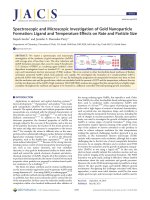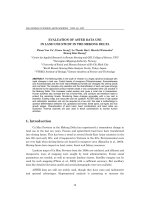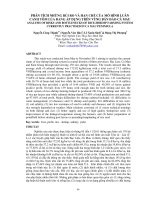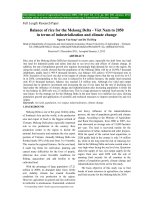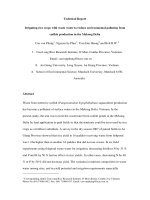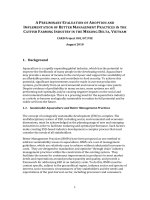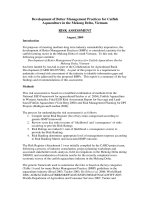Project Completion Report:" Investigation of rice kernel cracking and its control in the field and during post-harvest processes in the Mekong Delta of Vietnam - MS4 " docx
Bạn đang xem bản rút gọn của tài liệu. Xem và tải ngay bản đầy đủ của tài liệu tại đây (1.55 MB, 42 trang )
180
Ministry of Agriculture & Rural Development
Project Completion Report
MS14: PROJECT COMPLETION REPORT
026/05VIE
Investigation of rice kernel cracking and its control in the field and
during post-harvest processes in the Mekong Delta of Vietnam
APPENDIX 8A
EXTENSION WORKERS MANUAL-PART 1
IMPROVING FARMER’S PROFITABILITY BY MINIMIZING
GRAIN LOSS AND MAINTAINING QUALITY THROUGH
CORRECT PROCEDURES DURING HARVESTING AND POST-
HARVEST OPERATIONS
181
INTRODUCTION
Reduced whole rice grain yield and value due to cracking is one of the major issues that directly reduce
income and availability of staple food to the farmers in the Mekong River Delta. The cracking or partial
fissuring of rice kernels may occur right in the paddy field due to incorrect harvesting time/practice,
improper post-harvest drying conditions and inappropriate milling operations.
There is a chain of activities during harvesting and post-harvest processing of rice. Figure 1 is a
diagram showing a post-production system of rice in the MRD of Vietnam currently. All chains in this
system can contribute to losses. Some of the important factors can be dependent to each other. Here we
consider two aspects:
1. Grain loss (G): Harvesting and post-harvesting losses in which grain is not fully recovered during a
particular operation on farm
2. Value loss (V): Grain cracking and reduced head rice yield which result in downgrade in grain
quality value, such as broken rice during milling. The value of rice might be reduced by 50% or less.
Accordingly, the manual is divided into 4 sections in relation to:
1. Harvesting time,
2. Harvesting method,
3. Drying method, and
4. Milling
Harvesting loss is relevant only in the first two sections, while the grain cracking and head rice yield
are affected by activities during the harvesting as well as post-harvest.
The main factors which contribute to the rice cracking and value losses are:
• Harvesting time- before and after grain maturity
• Harvesting methods- manual, reaper, combined harvester
• Drying methods- sun drying and mechanical drying
• Milling losses- small, medium, large rice milling plants and milling procedure.
182
Types of Losses
Harvesting
Time At the mature date G
After the mature date G+V
Method Manual cutting + Hand collecting + Mechanical Threshing
Reaper + Hand collecting + Mechanical Threshing G+V
Reaper + Combined-Collector (collecting + threshing)
Combined-Harvester
Transportation G
Drying
Field drying G+V
Sun drying G+V
Mechanical drying Correct G
Incorrect G+V
Transportation G
Storage V
Transportation G
Milling
Small scale V***
Medium scale V**
Large scale V*
Figure 1: Post-production system of rice in the Mekong River Delta of Vietnam and loss
components. G is grain loss, V is value loss, *, ** and *** signs indicate relative degree of losses.
183
SUMMARY OF POST-HARVEST LOSSES
Table 2 is the summary of total post-harvest losses (Table 2) based on the data collected in the past two
years from Mekong Delta region. In this table, the values are the overall estimation from different
varieties. The values presented are in the relative term between the cases. For instance, late harvesting
has 3.5% of losses in comparison to harvesting at correct time. The value loss at correct harvesting time
is considered to be 0%.
• From the milling survey data, an average milling quality system caused a value loss of about
4% in comparison to a good quality system which was considered to be 0% value losses.
• Experimental data of flat-bed drying gave that incorrect drying procedure resulted in 5% value
losses in comparison to correct case which was considered to be 0% value losses.
• Sun drying of panicle means that paddy after cutting was left in the field for sun drying (field
drying). The value losses of 8.7% and 4% of field drying and sun drying on yard, respectively,
were the relative values compared to correct drying procedure.
Table 2: Overall evaluation of total post – harvest losses (late harvesting, moderate milling quality)
Harvesting
time
Harvesting
method
Threshing Sun drying Drying Milling
Total
(%)
Panicle(V=8.7%) 13.1
Yard(V=4%) 8.4
Correct(0%) 4.4
Manual/
Reaper
(G=2.9%)
Yes
(V=1.5%)
Incorrect (V=5%) 9.4
Yard(V=4%) 6.7
Correct(0%) 4.2
Correct
(V=0%)
Combined-
Harvester
(G=1.2%
V = 1.5%)
No
(0%)
Incorrect (V=5%)
Good
quality
(0%)
7.9
Panicle(V=8.7%) 20.6
Yard(V=4%) 15.9
Correct(0%) 11.9
Manual/
Reaper
(G=2.9%)
Yes
(V=1.5%)
Incorrect (V=5%) 16.9
Yard(V=4%) 14.2
Correct(0%) 10.2
Late
(V=3.5%)
Combined-
Harvester
(G=1.2%
V = 1.5%)
No
(0%)
Incorrect (V=5%)
Average
quality
(4%)
15.2
Note: V= Value losses, G = Grain losses.
There are three cases of losses that can be highlighted in Table 2.
1. The highest total losses is 20.6% including late harvesting (3.5%), manual cutting (2.9%),
threshing (1.5%), field drying (8.7%), incorrect drying procedure (5%) and using average
milling quality (4%).
2. The common cases of total losses are in the range of 12.4 to 15.9% including correct (or late)
harvesting time, manual cutting, threshing, sun drying on yard, average milling quality applied.
184
1. INFLUENCE OF HARVESTING TIME ON THE RICE
CRACKING AND QUALITY LOSSES
Physical grain losses during harvesting can be divided into various types, depending on the operation
and the machinery used.
Losses during cutting crops
• Shattering loss: shedding of mature grains from the panicle caused by birds, wind, rats, and handling.
• Lodging loss: plants with mature grains fall on the ground making the grains difficult to recover.
• Standing crop loss: standing plants with mature grains are left standing in the field after harvesting.
Losses during threshing and cleaning
• Separation loss or “blower loss”: grains that are mixed with straw or chaff during the cleaning operation.
• Scatter loss: grains that are scattered on the ground during the threshing and cleaning operation.
• Threshing loss or unseparated loss: mature grains that remain attached to the panicle in the straw after completion of
the threshing operation.
Losses during crop and grain handling:
• Handling loss: mature grain lost during lifting, hauling, stacking, pouring, and bagging of crop and grains.
Incorrect time of harvesting increases harvest losses. The main problem is caused by delayed
harvesting, as this increases susceptibility to shattering, lodging and standing crop losses.
Incorrect harvesting time is also one of the major factors that cause the losses due to cracking.
Cracking can develop in the field as a result of changes in grain moisture or moisture cycles after the
rice matures due to hot sunny days followed by humid nights. The cracking behaviour of the rice in the
field is expected to depend on the season due to the different patterns of temperature fluctuation during
day and night, degree and strength of sunshine and frequency of rain. During the rainy season, the rice
grain can develop cracks during the late maturity stage due to rewetting. At the same time, during dry
season it is likely that the grains over-dry if not harvested at correct time. Thus we need to identify the
correct time for harvesting.
Estimating the correct time of harvesting
Recommended time of harvesting for each variety is estimated from the time of sowing in each season.
Table 3 presents the estimated days from sowing to harvest for various varieties in MRD.
185
Table 3. Growing time recommended by extension center
Variety Recommended
growing time (day)
Variety Recommended
growing time (day)
OM1490 87-92 OM2517 85-90
OM2718 90-95 IR50404 90-95
Jasmine 95-105 OM4498 90-95
AG24 85-90
While this is useful way to estimate correct harvesting time, each crop differs in the correct harvesting
time, as some mature faster and others mature more slowly, e.g. crops affected by salinity.
Thus more accurate date of correct harvesting time can be made with observation during growth of
each crop. Probably the most common way is to estimate harvest time from the observation of heading
date, and add number of days to allow duration for grain filling. In dry season, an optimum time of
harvest is 28 to 35 days after heading. In wet season, optimum time is 32 to 38 days after heading.
(This needs to be converted to Vietnamese seasons I will find the data and add to this paragraph)
When the crop approaches the estimated optimum time of harvesting, then further observation is made
to determine the exact time of harvesting. For harvesting the grain moisture content ideally is between
20-25% (wet basis). Grains should be firm but not brittle when squeezed between the teeth. However,
in the Summer-Autumn season in Mekong Delta River, the moisture content is normally 28-30% due to
frequent rains. This means that prompt drying of grain is very critical to avoid rice cracking,
germination and fungal damage.
At around this time, the crop should be cut when 80-85% of the grains are straw (i.e. yellow) coloured
(see photograph).
Harvesting also needs to be timed so that threshing can be
done as soon as possible after cutting to avoid re-wetting
and reduce grain breakage. Thus, combine-harvester is the
best harvesting method.
If the crop has a lot of surface moisture, e.g. from previous
rainfall or early in the morning, it is advisable to wait to cut
the crop until the surface moisture dries off.
186
From the experiments on 7 rice varieties in three seasons in the past 2 years (2006-2008), the optimal
harvesting time to maximise head rice yield for each variety in each season (dry/rainy) is presented in
Table 4. Most of the cases fell within the recommended day mentioned in Table 3. However, some
cases were outside of this range such as OM2517 (94 days in rainy season), AG24 (94 days in rainy
season) and OM2718 (88 days in rainy season).
Table 4: Optimal growing time for highest HRY (coloured numbers are the optimal growing time
for harvesting)
Variety Season
Growing time (day)
Dry
88
90 92 94 96 98
OM1490
Rainy
88 90
92
94 98 104
Rainy
88
90 92 94 96 98
OM2718
Dry
88 90
92
94 96 98
Rainy
86 88 90 92
94
96
OM2517
Dry
82 84
86
88 90 92
Rainy
86 88 90 92
94
96
OM4498
Dry
87 89
91
93 95 97
Jasmine Rainy
94 96
98
100 102 104
AG 24 Rainy
86 88 90 92
94
96
IR50404
Rainy
88 90
92
94 96 98
Yield loss
Correct timing of harvest is crucial in order to prevent crop loss. Grain losses may occur from rats,
birds, crop lodging, insects, and shattering. Timely harvesting ensures good grain quality and high
market value.
Harvesting too early will result in a larger percentage of unfilled or immature grains, which will result
in a lower yield and in higher grain breakage during milling.
Harvesting too late will lead to excessive losses and increased breakage in rice.
Grain cracking and head rice yield (HRY)
The following figures (Figure 2 and 3) show the mean of grain cracking and also that of head rice yield
among several varieties obtained in Mekong Delta during 4 seasons of experiments in 2006-2008.
187
51.06
52.3
50.73
47.99
42.23
36.51
34.53
0
5
10
15
20
25
30
35
40
45
50
55
-6 -4 -2 0 +2 +4 +6
Harves ting time (days from maturity)
Head Rice Recovery (%
)
0.80
3.20
9.60
4.80
10.80
15.20
23.60
0
4
8
12
16
20
24
-6 -4 -2 0 +2 +4 +6
Harvesting time (days from maturity)
Grain cracks (%)
0.40 0.40
1.20
2.80
10.80
4.00
5.20
0
2
4
6
8
10
12
-6 -4 -2 0 +2 +4 +6
Harvesting time (days from maturity)
Grain cracks (%)
Variety: 1490 (Rainy season 2006) Variety: 2718 (Rainy season 2006)
Figure 2: Effect of harvesting time on grain cracking.
The X axis indicates days of early or late harvesting compared to maturity date (day 0).
45.41
51.47
43.54
43.91
38.76
36.83
40.72
0
5
10
15
20
25
30
35
40
45
50
55
-6 -4 -2 0 +2 +4 +6
Harvesting time (days from maturity)
Head Rice Recovery (%
)
Variety:OM 1490 (Rainy season 2006) Variety: OM2718 (Rainy season 2006)
Figure 3: Effects of harvesting time on head rice yield.
The X axis indicates days of early or late harvesting compared to maturity date (day 0).
Do Not harvest late after the
maturity date in order to avoid
cracking and to increase HRY
188
Table 5 summarises the losses due to late harvesting for different varieties harvested in different
seasons of MRD in 2006-2008. The HRY is reduced by 5-28% if harvesting time was 6 days late.
Assuming 1% of HRY reduction equivalent to 0.5% of losses (50% value loss), then late harvesting
would cause a loss of 2.5-14%. The varieties AG24 and IR50404 had losses below 2.5%, whereas the
varieties OM1490, OM2517 and OM2718 had high losses of above 5% (6 days late harvesting). Theses
varieties need to be harvested earlier.
Table 5: Losses of Head Rice Yield (HRY %) due to late or early harvesting.
Variety Season
Losses of HRY (%) in comparison to optimal harvesting time
Dry/Rainy??
0
1.57 4.31 10.07 15.79 17.77
OM1490
Rainy/Dry??
1.69 0.97
0
3.33 7.65 11.55
Rainy
0
7.93 7.56 12.71 14.64 10.75
OM2718
Dry
0.47 1.08
0
1.26 3.67 5.07
Rainy
5.08 11.36 7.05 4.77
0
4.9
OM2517
Dry
15.59 11.5
0
3.5 12.94
28.05
Rainy
4.65 6.59 3.07 4.55
0
7.07
OM4498
Dry
17.24 13.15
0
1.38 4.55 5.78
Jasmine Rainy
0.71 3.54
0
0.77 7.21 6.2
AG 24 Rainy
6.23 4.48 3.49 0.66
0
4.27
IR50404
Rainy
-0.25 0.89
0
5.97 1.29 2.16
Note: 0 is the optimal day. After (before) this day is late (early) harvesting. From one cell to the adjacent cell the harvesting
time changed by two days.
The survey data shows that most of the farmers were late harvesting by 1 to 3 days. For varieties,
OM1490, OM2718, Jasmine and AG24 were harvested late by 80%, 90%, 55% and 50% of farmers,
respectively.
1. The harvesting time is one of the important factors to control the rice cracking and eventual
head rice recovery. There is a clear trend that a few days early harvesting (before maturity) is
better than the late harvesting.
2. The same effect persists in rainy or dry season (check further data – more figures have been
inserted to Figure 2 &3).
3. Varieties differ in their grain cracking and those with small cracking such as AG24 is
recommended. When head rice recovery is also considered, OM4498 had smaller loss even it
Field experiments indicated
that: 4-6 days late harvesting
increase cracking by up to
24%, and reduce HRY by up to
28%.
189
was harvested later than the optimum harvest time (Check data further). In one of the varieties
tested in this investigation, a proportion of cracked rice was as high as 24%.
The results have highlighted the importance of rapid harvesting of the crop. Farmers are
encouraged to make their crop management in such a way that they can harvest earlier (e.g.,
organize labour for harvesting). This is expected to impact the farmers’ decision to determine the
harvesting time.
In addition, the farmers are encouraged to plant varieties with different maturities so that each crop
can be harvested at the correct time of harvesting. There may also be some opportunities to plant at
different times of the same variety, so that the harvesting is spread for a longer time period.
However, the best option is to introduce mechanical harvesting (see Section 2).
190
2. INFLUENCE OF HARVESTING METHOD ON THE RICE
CRACKING AND QUALITY LOSSES
Harvesting systems vary from region to region and include different methods for harvesting, hauling,
threshing and cleaning. The goal of good harvesting is to ensure maximum grain yield through
minimizing grain loss and the prevention of quality deterioration, including cracking.
A wide variety of harvesting tools is used, such as knives, sickles, animals, stationary threshing
machines, tractor-mounted harvesters, and self-propelled
combine harvesters. In Vietnam including
Mekong River Delta, the most common systems for paddy harvesting are:
1. Manual harvesting, collecting by hand, followed by machine threshing (no more manual threshing in
Vietnam)
Manual cutting Manual collecting Machine threshing
2. Harvesting by reaper, manual collecting followed by machine threshing
Cutting by reaper Manual collecting Machine threshing
A lot of labours are required for manual collecting after harvesting by reaper.
191
3. Machine harvesting with a reaper, followed by combined collection-threshing.
Cutting by reaper Combined collection and harvesting
Cutting and laying the crop on a windrow is done using a reaper, followed by collection and
threshing using a machine.
4. Combine harvesting.
The combine harvester combines all operations: cutting, handling, threshing and cleaning
192
Table 6: Advantages, disadvantages of the applied harvesting methods used in the Mekong Delta
Method Advantages Disadvantages
Multi-step harvesting:
+ Manual harvesting, field drying,
piling and threshing
- Cut rice stem is short reducing
threshing energy.
- Field drying reduces energy for
drying and threshing.
- Independent to soil condition and
the degree of lodged rice.
- High cleanness of rice.
- Low capacity, require a large number
of labours.
- Grain shattering is high due to manual
cutting and piling.
- Bad grain quality due to uneven
moisture content; especially if it rains
before threshing (cause fissure,
germination, discolouration).
Dependency on availability of
contractor
Piling: a hard work
The grain germinated
20 hours after
harvesting due to
wetting in the rain
(Spring-Summer)
+ Harvesting by reaper, field
drying, piling, threshing
- The machine is not heavy, high
capacity (1-6 ha/day); it can work
in the soft soil field.
- The strength of reaper is
moderate and rarely damaged
seriously. The spare parts are
available locally.
- High cleanness of rice.
- High mobility.
- Moderate investment.
- High amount of rice stem (2-3 times
compared to manual harvesting)
increased time and energy for piling
and threshing; it’s hard to harvest
lodged rice. This is the major
disadvantage of the reaper.
- High losses during harvesting and
piling over-matured rice.
- Grain quality is not as good as in the
case of manual harvesting if field
drying is applied.
Harvesting by reaper, combine-
collection and threshing
- The reaper machine is not heavy,
high capacity (1-6 ha/day); it can
work in the soft soil field.
- The combine- collecting and
threshing machine can work in soft
soil field where heavy combine
harvester could not work.
- High capacity, less labours
requirement
- Higher capital cost
- More straw left behind in the field
- The mobility of the machine in the
field depends on the weight of machine
and the size of field.
One step harvesting:
+ Harvesting by combine-
harvester (axial flow threshing)
- High capacity.
- Only one operator and one
worker are required for running
the machine.
- The mobility of the machine in the
field depends on the weight of machine
and the size of field.
- Hard to harvest lodged rice.
193
- Grain quality good.
- The machine consists of many parts
and elements which lead to complex
operation and maintenance.
- Degree of cleanness is not high when
grain moisture is high.
- The mobility is not high where the
chain is used.
The investment cost is high.
Estimated harvesting losses
Harvesting losses consist of shattering and threshing losses. Table 7 shows each component and total
harvesting losses. The total harvesting losses can be as high as 4.4%. A threshing loss of 1.0% for
combine harvester was estimated by the manufacturer. On an average, mechanical harvesting reduces
harvesting losses.
Table 7: Effect of harvesting methods on the harvesting losses
Harvesting method
Shattering
losses (%)
Threshing
losses (%)
Harvesting
losses (%)
Hand and heaped immediately 1.4 2.6-4.4
Hand
Hand and dried in the sun (one
day)
1.2-3.0
1.2 2.4-4.2
Reaper and heaped
immediately
1.1 1.8
Reaper
Reaper and dried in the sun
(one day)
0.7
0.8 1.5
Combined
harvester
1.3-1.5 1.0 2.3-2.5
The information shown above is for the case when crops are harvested at a correct time. Due to longer
time required for harvesting, it is likely that manual harvesting will result in greater delay in harvesting
time, and hence greater harvest losses.
Thus,
• Shattering loss due to harvesting method and also due to time of harvesting (particularly late
harvesting) is an important factor to consider for reduction in the grain losses during harvesting.
• Machine harvesting is beneficial in terms of quick harvesting of the crop and hence in terms of
minimizing harvesting losses
194
Grain cracking and head rice yield (HRY)
Effect of harvesting method
Harvesting method as such may not affect grain cracking and head rice recovery (Check), but manual
harvesting often results in delayed harvesting, and this can cause grain cracking and reduced head rice
recovery. Thus, when harvesting is to conducted to be manually, it is important to time the operation so
that crops can be harvested at correct time.
In addition, manual harvesting results in higher scattering losses in comparison to machine harvesting.
Data collected from some farmers who harvested manually are presented in Table 8.
Table 8: Scattering losses in the field of different farmers harvested manually
Farmer Rice
variety
Initial rice
moisture
(before
harvesting)
(% wb)
Moisture
content of
rice
during
threshing
(% wb)
Number
of kernels
scattered
per 25m
2
(g)
Productivity
(kg/1000m
2
)
%
losses
1 OM 2517 23.4 28.9 445 550 2.6
2 20.4 26.5 320 450 2.2
3 24.5 29.3 182 380 1.6
4 23.8 27.9 290 440 2.2
5 22.9 28.4 220 480 1.5
6
AG 24
18.9 19.4 538 400 5.2
7 22.5 24.8 285 350 3.6
8
OM 1490
20.3 23.7 298 300 4.6
9 22.8 19.4 262 380 2.3
10 27.6 22.1 305 400 2.4
11
OM 2718
18.9 19.4 318 380 3.4
Average 2.9±0.9
Effect of threshing method on grain cracking and head rice recovery
The threshing method applied can cause the cracking in the rice kernels and eventually reduce the head rice
recovery. The data collected in two provinces in Mekong Delta at the same time when experiments were
conducted are presented in Table 9. The results indicate that the grain cracking is not significantly affected by
the method of threshing. However, some reduction of head rice recovery was observed in the case of rice
threshed by machine.
Table 9: Effect of threshing method on rice cracking and head rice recovery
Grain cracking (%)
Brown rice White rice
Head rice recovery
(%)
Rice varieties
Hand Machine Hand Machine Hand Machine
OM2718/
OM 1490
4.1 3.9 3.0 1.8 49.9 46.7
An Giang 24 0.9 2.4 1.5 0.7 45.6 44.0
195
Ministry of Agriculture & Rural Development
Project Completion Report
MS14: PROJECT COMPLETION REPORT
026/05VIE
Investigation of rice kernel cracking and its control in the
field and during post-harvest processes in the Mekong Delta
of Vietnam
APPENDIX 8B
EXTENSION WORKERS MANUAL-PART B
IMPROVING FARMER’S PROFITABILITY BY
MINIMIZING GRAIN LOSS AND MAINTAINING
QUALITY THROUGH CORRECT PROCEDURES
DURING HARVESTING AND POST-HARVEST
OPERATIONS
196
3. EFFECT OF DRYING METHODS ON RICE
CRACKING AND HEAD RICE RECOVERY
Importance of drying
Drying is the process of removing water from the grains to reach safe storage
moisture content (MC). Rice is harvested at grain moisture content between 20 and
30% (wet basis), depending on the season of harvest. Failure to dry the rice often
results in its deterioration due to micro-organisms and discolouration. Depending on
the desired storage period there are different recommended moisture contents for safe
storage (Table 10).
Table 10: Safe storage period of rice at different moisture content.
Storage period Desired moisture content
(w/w)
Potential problems at higher
moisture content
2 to 3 weeks 14 - 18% Molds, discoloration,
respiration loss
8 to 12 months 13% or less Insect damage
More than 1 year 9 % or less Loss of viability
Delays in drying, incomplete drying or uneven drying will result in qualitative and
quantitative losses including:
• Yellowing or discoloration caused by mold development and heat build-up
from respiration
• Development of rice cracks with eventual reduced milling yields caused by
high temperatures and re-wetting of grains
• Loss of germination and vigor caused by grain respiration, mold and insect
activities, or from exposure of grains to temperatures above 42ºC
• Damage caused by insects that are more active at higher moisture levels
Principles of drying
Drying of grains involves exposing grains to ambient air with low relative humidity or
to heated air or to the sun. The moisture evaporates from the grain and then the drying
or ambient air removes the moisture from around the surface of grain.
Drying methods
After harvesting (cutting in the field) the rice lots are dried by different methods:
197
1. Field drying
2. Sun drying
3. Artificial drying
Field drying
Field drying is practiced prior to threshing when hand or reaper is used for cutting the
rice. The drying rate will highly dependent on the weather condition and the stage of
harvesting. There are losses due to shattering of the grain and rice cracking due to
over drying or rewetting of the grain, if the rice is not threshed in time. The major
disadvantages of this method are:
Rewetting from straw or soil which can cause rice
cracking and high proportion of broken rice during
milling
Rewetting during night time due to high humidity
resulting in grain cracking and low milling yield
Non-uniform drying due to uneven spreading of the
stack. Grains outside will dry faster than the inside
the stack.
The experimental results presented in Table 11 indicate that there will be reduced
head rice yield due to field and sun drying.
Table 11: Loss of head rice yield (HRY) in equivalent to losses of paddy (kg/100
kg yield) for different varieties in the Mekong Delta due to current practices of
field and sun drying
Variety OM1490 OM2718 Jasmine AG24
Loss of head rice yield (%)
7.32 8.97 10.45 7.87
Sun drying
Sun drying is the common drying method practiced by farmers in Vietnam including
Mekong Delta. In this method, the rice grains are spread under the sun after threshing
operation. The rice is normally spread on the concrete, asphalt or plastics. It is a low
cost but labour intensive drying. The control of grain temperature is difficult. The top
layer of the rice bed will heat more than the interior of the bed. Regular mixing is
practiced to minimise the temperature and moisture differences between the layers of
bed.
Sun drying has some limitations:
198
• Not possible during rain and at night. Any delay leads to excess respiration
and fungal growth causing losses and yellowing.
• Labor intensive and has limited capacity.
• Overheating causes cracking of some grains and result in low milling quality.
• Mixing operation is labour intensive and is difficult to handle in large
amounts.
Table 12: Milling losses (head rice yield reduction) due to sun drying as
compared to artificial drying (in dry season)
Head Rice Yield, %
Variety
In shade
drying
(controlled
sample)
Mechanical
drying (Flat-bed
dryer)
Sun drying
(Plastic, Ts =
42-48
o
C)
HRY reduction due
to sun drying (%)
OM1490
OM2517
Jasmine
Sticky rice
49.1
48.7
50.4
50.6
49.6
49.1
50.7
51.3
47.5
45.3
44.6
48.2
2.1
3.8
6.0
3.1
Note:. Ts is the grain surface temperature
On average, losses due to field and sun drying were found around 8.7% (Table 11). This loss
is for winter-spring season. The losses in the wet season (Summer-Autumn crop, July/August)
are expected to be much higher due to changeable weather of rain and storm.
Artificial drying
Artificial drying is used to dry the grain faster than the traditional method in a control
condition. The artificial drying is better than sun drying in terms of grain quality and
milling yield. In this method the drying air is blown across or over the bed of grain to
drive moisture out from the grain. The drying temperature and conditions are
correctly selected in order to avoid the grain cracking.
There are low, medium and high temperature dryers. The low temperature dryers use
below <35
o
C (or just use ambient air if the humidity of the air is low enough). Low
temperature drying is very slow process but it is gentle enough to minimise rice
cracking during water removal due to low moisture differential in the grain at a given
time. However, this is not economical because the drying rate is very slow. Medium
temperature dryer may use 35-50
o
C drying air temperature. This is the most practiced
condition, but it can cause grain cracking if the drying temperature condition is not
properly controlled. High temperature dryer may use above 60
o
C. High temperature
drying can cause rice cracking resulting from the moisture driven mechanical stress
due to faster drying from the exterior surface of the grain than from the interior.
199
Therefore, an additional intermittent tempering process is necessary to allow moisture
to equilibrate from interior to exterior and reduce the differential moisture.
There are various types of dryers are used.
Bin drying
This is a low temperature drying method. Paddy with moisture
content already below 18% can be slowly dried in storage bins
using aeration with slightly pre-heated air. Since there is not
mixing of the grain involved, the grains close to the air entry
point will dry faster than the interior. Some cracking of grain
may occur at the entry point if the temperature is a bit high and
the humidity of the air is very low. This type of drying method is
not a common practice in Mekong River Delta.
Flat bed drying (FBD)
This is the most common dryer found in Mekong
delta. Flat bed driers are also called fixed-bed dryer.
In this dryer the heated air is forced through the bulk
grain. The grain is kept stationary in a holding bin
until drying is completed. The dryer capacity is
flexible, can range from 1 to 10 tons. 10 ton/batch is
the maximum size in terms of labor management. On
average drying time is 7-10 hrs depending on the
initial moisture content. Bed configurations of fixed-
bed batch dryers can either be rectangular (flat-bed
dryer), inclined for better unloading or circular. The
recommended drying temperature is 43-45
o
C.
Figure 1: 8-ton flat bed drier
Fixed-bed batch dryers produce better grain quality than sun-drying. They are more
affordable than re-circulating batch dryers of the same capacity or continuous flow
dryers and have certain advantages:
• Easy to operate
• Simple design allows local production of the drying bin, blower and furnace
and ensures easy maintenance and repair.
• Heating system (furnace) usually uses rice husk as fuel.
• The air blower can be operated with a gasoline or diesel engine in areas where
electricity is not available or too expensive.
• The same dryer can be used for other grains such as corn.
Some important points to remember while operating flat bed dryers (FBD).
• Load the drying bin evenly. If some lots of rice contain different moisture
content, mix all before drying.
200
• For very wet grain aerate the grains for 30-60 minutes before drying. This will
improve quality, although it may increase drying time and fuel consumption.
• Monitor moisture content and temperature hourly. Stop drying when the
moisture content in the middle of the bulk (half grain depth) reaches the
desired final moisture content.
• For seeds don’t exceed 43°C drying air temperature.
• Increasing the temperature reduces drying time but increases uneven drying
and can cause rice cracking
• Increasing the airflow shortens drying and reduces the moisture content but
increases energy cost.
• Mixing during drying reduces the moisture gradient.
Schematic diagram of furnace
Rice husk furnace with cylindrical ash collector.
Automatic rice husk furnace.
Due to the large depth of the grain and drying passing though one end, there is a difference in
moisture content between the bottom and the top bed. Mixing reduces this difference, but the
mixing can not be efficient and is labour intensive. In order to simplify, a reversible air flow
is used after certain period of drying.
Figure 2: 1-ton reversible dryer
Drying Air
UP
Grain
CONVENTIONAL SHG
FLAT-BED DRYER
Floor : 50 sq.m / 8 ton
0.3m
201
Table 14: Comparison of quality of rice obtained from reversible and non-reversible
mode in 1 ton-dryer (drying temperature 46
o
C for the first 1.5 hr followed by drying at
43
o
C for the remaining time, air flow= approx.5.8 m
3
/min, paddy mass 9200 kg)
Batch Number Reversible
Non-
reversible
Drying time 6.00 6.00
Air reversal time, minute 15
Labour personnel for air reversal 2
Initial moisture content (% wb) 23.9 20.4
Final moisture content (% wb) 14.9 16.1
Top layer moisture (% wb) 13.9 18.2
Middle layer moisture (% wb) 16.2 16.4
Bottom layer moisture (% wb) 14.8 13.6
Differential moisture Top-Bottom (%) 0.83 4.64
Differential moisture Middle-Top (%) 2.24
Rice husk consumption: kg/batch 171.2 215.2
Rice husk consumption: kg/hr 28.5 35.9
Diesel consumption (for fan), L/h 1.70 1.75
Initial Paddy layer, mm 517.8 507.8
Brown rice cracks before drying (%) 12.0 21.0
Brown rice cracks after drying (%) 13.8 23.8
Cracks during sun drying- cement yard, 7 cm layer (%) 17.8 26.8
Head Rice Recovery (%)
Head Rice %, after drying 59.39 56.21
Head Rice %, Sun drying 55.58 52.12
Difference (Sun & Mechanical) % -3.81 -4.09
High temperature compact dryer
In large capacity, fluidised bed and column continuous dryer can be used. Use of high
temperature accelerates the drying rate but can cause rice cracking. Since the temperature and
exposure time should be critically controlled, these types of dryers have not been used in the
farm level in Vietnam.
In the fluidised bed dryer, the rice is fluidised by the air entering to the bed at higher
pressure at the bottom of the bed. The air velocity passing though the perforated plate
is high enough to lift the grains. As the grains are lifted, the air escapes and the grains
fall down due to gravity. The cycle repeats and the whole bed of grains appears like a
fluid. Column drying is a high cost drying method compared to flat-bed drying. High
temperature, fluidised bed drying is cheaper to dry the moisture down to 18%.
Therefore, two-stage drying, fluidised bed drying followed by a flat-bed drying, can
reduce the total drying cost and increase the throughput of the drying operation. The
202
increased throughput per unit area of the plant requires less land space, thus is a viable
option in the milling plant.
Column dryer Fluidised-bed dryer
Table 16: Drying cost for different driers used in Mekong Delta (Data collected from
Long-An province)
Mode VND /kg
SRA-4 (reversible, 4-ton/batch) dryer, with rice husk furnace 98
SRA-8 (reversible, 8-ton/batch) dryer, with rice husk furnace 79
SDG-4 (reversible, 4-ton/batch) dryer, with rice husk furnace #1 80
SDG-4 (reversible, 4-ton/batch) dryer, with coal furnace 130
Sun drying, in the dry-season harvest
70
Sun drying, in the wet-season, normal (moderate) weather 140
Sun drying, in the wet-season, ADVERSE weather 210
# dryer uses the typical fan design developed by NLU
203
4.
LOSSES DURING RICE MILLING
Rice milling is the process of removing the husk and bran layer to produce white rice.
The process is undertaken as:
• A one step milling process where the husk and the bran are removed in one
pass and white rice is produced directly from the paddy.
• A two-step process where the husk and the bran are removed separately, and
the brown rice is further processed to get white rice.
• A multistage process where rice passes through a number of different
operations and machines from paddy to white rice.
The head rice yield (%) is the important criteria used to evaluate the milling quality of
rice. The head rice means the whole grain unbroken rice which has at least 75% of the
original length of the brown rice. In an ideal condition the head rice recovery is
expected to be above 59%. Rice cracking occurred prior to milling due to improper
harvesting and subsequent drying practices, presence of immature grain, chalkiness in
the grain and milling conditions are the main contributors of low head rice yield.
The head rice recovery will not only depend on the initial rice quality (existing cracks or
weaker grain), but also on the efficiency of the milling operation.
There exist three systems of rice mills in Mekong Delta (Kien Giang and Tien Giang
provinces):
1. The traditional white rice milling system: A complete rice milling plant
without polishing (around 91% rice mills).
2. The……… (around 3% rice mills).
3. The final rice whitening/polishing plant (around 6% rice mills).
204
1. Hopper
2. Feedback paddy
3. Sieve
4. Cyclone
5. Tank
6. Whitening disk
7. Blower
8. Rubber huller
9. Rubber huller
10.
Rubber huller
11.
Husk seperation
12.
Blower
13. Sieve
14. Tank
15. Whitener 1
16. Cyclone
17. Scale
18. Sieve
19. Polisher
20. Whitener 2
21. Tank
22. Cyclone
23. Tank
24. Whitener 3
Figure 3: Schematic of traditional milling system
The head rice is usually low for smaller mills due to poor efficiency of the milling systems
caused by lack of maintenance and incorrect operations. Head rice recovery in small scale
mills can be as low as 33%. Large rice mill had the highest head rice recovery of 55%. In
literatures, the head rice recovery and total rice recovery have been achieved as high as 60%
and 70%. Therefore, there is still scope of improving the head rice recovery even in large
scale mills, let alone a poor performer small scale rice mills.
Table 17: Head rice recovery data collected by surveying the millers (Kien Giang
and Tien Giang provinces)
Scale
Grain moisture
(%)
Average head rice
recovery (%)
Broken rice
(%)
Small 16 47-48 18-22
Medium 16 50-52 17-18
Large 16 52-55 16-17

